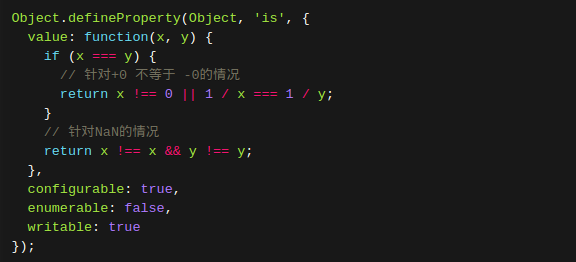[JS] ECMAScript 6 - Object : compare with c#
Ref: 对象的扩展
Outline:
- 属性的简洁表示法
- 属性名表达式
- 方法的 name 属性
- Object.is()
- Object.assign()
- 属性的可枚举性和遍历
- Object.getOwnPropertyDescriptors()
- __proto__属性,Object.setPrototypeOf(),Object.getPrototypeOf()
- super 关键字
- Object.keys(),Object.values(),Object.entries()
- 对象的扩展运算符
简洁表示法
ES6 允许直接写入变量和函数,作为对象的属性和方法。这样的书写更加简洁。
- 属性:
// 推荐
function f(x, y) { return {x, y}; } // 等同于 function f(x, y) { return {x: x, y: y}; } f(1, 2) // Object {x: 1, y: 2}
- 方法:
// 推荐
const o = { method() { return "Hello!"; } }; // 等同于 const o = { method: function() { return "Hello!"; } };
- 变量名就是属性名的写法:
let ms = {}; function getItem (key) { return key in ms ? ms[key] : null; } function setItem (key, value) { ms[key] = value; } function clear () { ms = {}; } module.exports = { getItem, setItem, clear }; // <---- 如此,简洁了许多
// 等同于 module.exports = { getItem: getItem, setItem: setItem, clear: clear };
- 属性的赋值器(setter)和取值器(getter):
const cart = { _wheels: 4,
// 采用了简洁的写法 get wheels () { return this._wheels; }, // 采用了简洁的写法 set wheels (value) { if (value < this._wheels) { throw new Error('数值太小了!'); } this._wheels = value; } }
- 定义属性名 - 把表达式放在方括号内
let lastWord = 'last word'; const a = { 'first word': 'hello', [lastWord]: 'world' }; a['first word'] // "hello" a[lastWord] // "world" a['last word'] // "world"
- 定义方法名 - 把表达式放在方括号内
let obj = { ['h' + 'ello']() { return 'hi'; } }; obj.hello() // hi
雷区:注意对[...]的理解
// 报错 const foo = 'bar'; const bar = 'abc'; const baz = { [foo] }; // bar有不是值,当然不能这么写;[]只是告诉编译器,你需要计算一下才能得到结果 // 正确 const foo = 'bar'; const baz = { [foo]: 'abc'};
雷区:[keyA]和[keyB]得到的都是[object Object],所以[keyB]会把[keyA]覆盖掉,而myObject最后只有一个[object Object]属性。
const keyA = {a: 1};
const keyB = {b: 2};
const myObject = {
[keyA]: 'valueA',
[keyB]: 'valueB' // Object的内部细节看不到,所以就引发了”覆盖“.
};
myObject // Object {[object Object]: "valueB"}
对象方法的 name 属性
返回函数名(即方法名)。

get or set方法,需要特殊处理:
const obj = { get foo() {}, set foo(x) {} }; obj.foo.name // TypeError: Cannot read property 'name' of undefined const descriptor = Object.getOwnPropertyDescriptor(obj, 'foo'); // <---- 需要特殊处理 descriptor.get.name // "get foo" descriptor.set.name // "set foo"
有两种特殊情况:
bind方法创造的函数 --> name属性返回bound加上原函数的名字;
Function构造函数创造的函数 --> name属性返回anonymous。

如果对象的方法是一个 Symbol 值,那么name属性返回的是这个 Symbol 值的描述。
key1对应的 Symbol 值有描述,key2没有。

Object.is()
给相等运算符(==)和严格相等运算符(===)进一步加了补丁。
与严格比较运算符(===)的行为基本一致。
不同之处只有两个:一是+0不等于-0,二是NaN等于自身。
Object.is('foo', 'foo')
// true
Object.is({}, {})
// false
+0 === -0 //true
NaN === NaN // false
Object.is(+0, -0) // false
Object.is(NaN, NaN) // true
ES5 可以通过下面的代码,部署Object.is。【给es5一个打补丁的机会】

Object.assign()
将源对象(source)的所有可枚举属性,复制到目标对象(target)。This is 是浅拷贝!
如果目标对象与源对象有同名属性,或多个源对象有同名属性,则后面的属性会覆盖前面的属性。
const target = { a: 1, b: 1 };
const source1 = { b: 2, c: 2 };
const source2 = { c: 3 };
Object.assign(target, source1, source2);
target // {a:1, b:2, c:3}
如果只有一个参数,Object.assign会直接返回该参数。
如果该参数不是对象,则会先转成对象,然后返回。【强制类型转换】
雷区:由于undefined和null无法转成对象,所以如果它们作为参数,就会报错。
Object.assign(undefined) // 报错 Object.assign(null) // 报错
雷区:如果undefined和null不在首参数,就不会报错。
let obj = {a: 1};
Object.assign(obj, undefined) === obj // true
Object.assign(obj, null) === obj // true
雷区:只有字符串的包装对象,会产生可枚举属性;数值和布尔值都会被忽略。
const v1 = 'abc'; const v2 = true; const v3 = 10; const obj = Object.assign({}, v1, v2, v3); console.log(obj); // { "0": "a", "1": "b", "2": "c" }
Object(true) // {[[PrimitiveValue]]: true}
Object(10) // {[[PrimitiveValue]]: 10}
Object('abc') // {0: "a", 1: "b", 2: "c", length: 3, [[PrimitiveValue]]: "abc"} // 可见,只有字符串的包装对象,会产生可枚举的实义属性,会被拷贝。雷图:属性名为 Symbol 值的属性,也会被Object.assign拷贝。
Object.assign({ a: 'b' }, { [Symbol('c')]: 'd' })
// { a: 'b', Symbol(c): 'd' }
把数组视为对象,以及同名属性(index)的替换
Object.assign([1, 2, 3], [4, 5]) // [4, 5, 3]
取值函数的处理
const source = { get foo() { return 1 } }; const target = {}; Object.assign(target, source) // { foo: 1 }
常见用途
- 为对象添加属性/方法
class Point { constructor(x, y) { Object.assign(this, {x, y}); // 将x属性和y属性添加到Point类的对象实例 } }
// 方法
Object.assign(SomeClass.prototype, { someMethod(arg1, arg2) { // 直接写进来即可 ··· }, anotherMethod() { // 直接写进来即可 ··· } });
----------------------------------------------------------------------- // 等同于下面的写法 SomeClass.prototype.someMethod = function (arg1, arg2) { ··· }; SomeClass.prototype.anotherMethod = function () { ··· };
- 克隆对象
function clone(origin) { return Object.assign({}, origin); }
// 如果想要保持继承链,可以采用下面的代码
function clone(origin) { let originProto = Object.getPrototypeOf(origin); return Object.assign(Object.create(originProto), origin); }
- 合并多个对象
const merge = (target, ...sources) => Object.assign(target, ...sources); const merge = (...sources) => Object.assign({}, ...sources); // 合并后返回一个新对象
- 为属性指定默认值
const DEFAULTS = { logLevel: 0, outputFormat: 'html' }; function processContent(options) { options = Object.assign({}, DEFAULTS, options); // 将DEFAULTS和options合并成一个新对象,如果两者有同名属性,则option的属性值会覆盖DEFAULTS的属性值。 console.log(options); // ... }
--------------------------------------------------
const DEFAULTS = {
url: {
host: 'example.com',
port: 7070
},
};
processContent({ url: {port: 8000} }) // 不是替换port,而是直接把url给覆盖掉了,哈哈
// {
// url: {port: 8000}
// }
属性的可枚举性和遍历
- 属性的描述对象(Descriptor)
描述对象(Descriptor),用来控制该属性的行为。
- Object.getOwnPropertyDescriptor方法
如下:描述对象的enumerable属性,称为”可枚举性“,如果该属性为false,就表示某些操作会忽略当前属性。
-
-
for...in循环:只遍历对象自身的和继承的可枚举的属性。Object.keys():返回对象自身的所有可枚举的属性的键名。JSON.stringify():只串行化对象自身的可枚举的属性。Object.assign(): 忽略enumerable为false的属性,只拷贝对象自身的可枚举的属性。
-
- Object.getOwnPropertyDescriptors方法
ES2017 引入了Object.getOwnPropertyDescriptors方法,返回指定对象所有自身属性(非继承属性)的描述对象。
例一:
let obj = { foo: 123 };

例二:
Object.getOwnPropertyDescriptor( Object.prototype, 'toString' ).enumerable // false Object.getOwnPropertyDescriptor( [], 'length' ).enumerable // false Object.getOwnPropertyDescriptor( class {foo() {}}.prototype, 'foo' ).enumerable // false
ES6 规定,所有 Class 的原型的方法都是不可枚举的。
- 属性的遍历
(1)for...in
(2)Object.keys(obj)
(3)Object.getOwnPropertyNames(obj)
(4)Object.getOwnPropertySymbols(obj)
(5)Reflect.ownKeys(obj)
以上的 5 种方法遍历对象的键名,都遵守同样的属性遍历的次序规则。
-
- 首先遍历所有数值键,按照数值升序排列。
- 其次遍历所有字符串键,按照加入时间升序排列。
- 最后遍历所有 Symbol 键,按照加入时间升序排列。
Reflect.ownKeys({ [Symbol()]:0, b:0, 10:0, 2:0, a:0 })
// ['2', '10', 'b', 'a', Symbol()]
遍历对象
ES2017 引入了跟Object.keys配套的Object.values和Object.entries,作为遍历一个对象的补充手段,供for...of循环使用。
- Object.keys()
let {keys, values, entries} = Object; let obj = { a: 1, b: 2, c: 3 }; for (let key of keys(obj)) { console.log(key); // 'a', 'b', 'c' } for (let value of values(obj)) { console.log(value); // 1, 2, 3 } for (let [key, value] of entries(obj)) { console.log([key, value]); // ['a', 1], ['b', 2], ['c', 3] }
- Object.values()
只返回对象自身的可遍历的属性,比如value是个对象,那么就要将该对象内的enumerate设置为true,才能遍历到。
const obj = Object.create({}, {p: {value: 42}});
Object.values(obj) // []
-------------------------------------------------
const obj = Object.create({}, {p:
{
value: 42,
enumerable: true
}
});
Object.values(obj) // [42]- Object.entries()
返回一个数组,成员是参数对象自身的(不含继承的)所有可遍历(enumerable)属性的键值对数组。
解构赋值与扩展运算符
略,之前已有总结。



 浙公网安备 33010602011771号
浙公网安备 33010602011771号